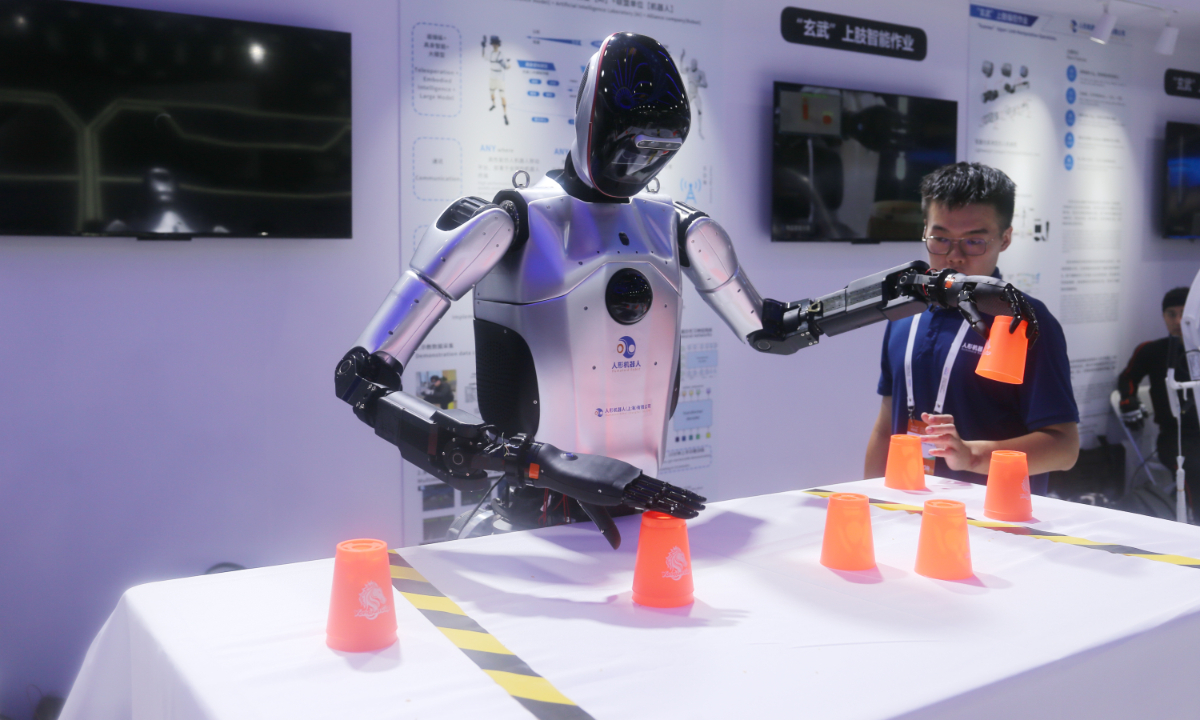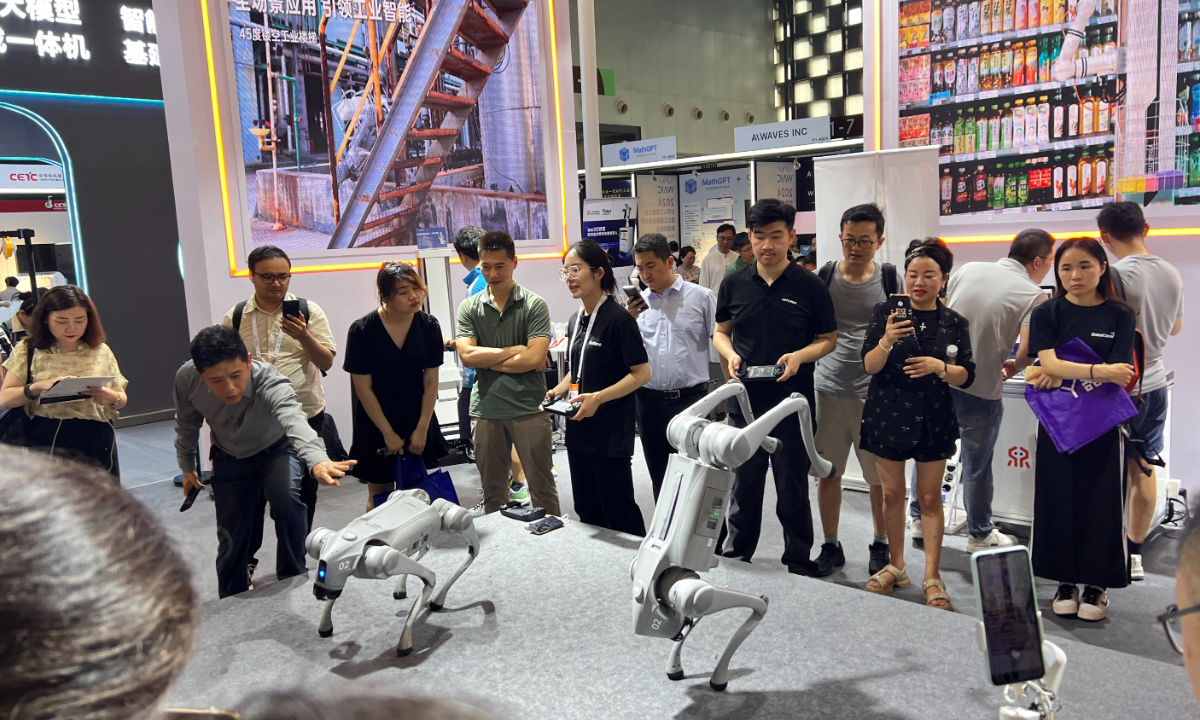OpenAI's cut of China's access to its API service would 'push domestic developers to catch up vigorously'

Visitors watch a robotic dog performance at an exhibition during the World AI Conference, on July 6, 2024. Photo: Leng Shumei/GT
US tech firm OpenAI has restricted access to its artificial intelligence (AI) models through its application programming interface (API) service in China since Tuesday.
The Global Times interviewed several Chinese AI developers and users, who generally agreed that the ban was not anticipated to have a significant impact on the domestic industry as OpenAI's products were not officially available in China anyway. In fact, some believed that this restriction will motivate Chinese developers to redouble their efforts to compete in the AI development and application sector.
What implications does this ban have for Chinese AI developers on a more granular level? And what is the actual gap between China and the US in terms of AI development? How should the two AI giants lead the world in AI developing and governance?
The other boot drops
API refers to interface that allows external access, which means that third-party developers can integrate ChatGPT's capabilities into their applications, building their own AI software. In March 2023, OpenAI announced the opening of the API, allowing third-party developers to integrate ChatGPT into their applications and services through an API.
The Global Times perused the OpenAI website on Tuesday and found that the company had published a list of 188 countries and regions where its API service is officially available, excluding the Chinese mainland, China's Hong Kong, or Macao regions.
"Accessing or offering access to our services outside of the countries and territories listed below may result in your account being blocked or suspended," OpenAI said on its website.
According to media reports, there were two main channels for developers to access OpenAI's products in China: By connecting to OpenAI's official API service or by connecting to Microsoft's Azure services.
Azure is reportedly the only legal way to access OpenAI products and services in China. In a report by US-based news portal PYMNTS.com on Monday, a Microsoft spokesperson was quoted as saying that Microsoft will maintain its Azure OpenAI Service offerings in China, and will continue to provide access to eligible customers in the country via models deployed in regions outside of China.
OpenAI's suspension may be a result of several factors, according to analysts.
First, legal compliance must have been taken into account as of June 21, as just a few days before OpenAI made the move, the US Department of the Treasury issued draft rules to ban or require notification of certain investments in AI and other technology sectors in China that could threaten US national security.
At the same time, China has also been enhancing the implementation of laws and regulations on cybersecurity and data security law. Requirements for cross-border data transmission and processing have been raised, making OpenAI faces more complex compliance procedures and high costs in the Chinese market.
In addition, the need to train GPT-5 and a shortage of computing power may also be part of the reason as some industry insiders told the media that they had been receiving shorter responses from ChatGPT recently.
Meanwhile, the move is also believed to help OpenAI to crack down on companies that "package" OpenAI technology as their own product, driving out companies without core technology and competitive strength from the market.
Chinese industry insiders pointed out that most Chinese companies will suffer little from this time's service suspension. They will either transfer to domestic large models, or purchase OpenAI's services via Microsoft or other providers outside China. In the long run, this move may be good to China's independent development of large models and self-reliance.
Chinese domestic large model developers have been ready to take customers from OpenAI. Companies like Moonshot, Zhipu AI, Baidu, Alibaba, Zero One Wanwu, and other large model manufacturers, took immediate action to release their "relocation plan" for OpenAI API users.
At the exhibition during the World AI Conference (WAIC) held between June 4 and June 7 in Shanghai, the Global Times noted that various large model manufacturers in the Chinese mainland and Hong Kong are now providing relocation services
Chinese large model manufacturers are also ready to "go global." A fund manager in Beijing told stcn.com that domestic large model developers are striving to catch up with the US. If these developers have plans to explore overseas markets, they can set up branches in countries and regions where OpenAI is legally available.
Visitors watch a robotic dog performance at an exhibition during the World AI Conference, on July 6, 2024. Photo: Leng Shumei/GT
The true gap
But OpenAI's move did sound an alarm for Chinese large model developers to reflect on the gap between them and their US competitors.
Take generative AI, one of the most widely used and the most widely known field of today's AI development, as an example.
Both the US and China are leaders in the generative AI field. But the US does better in cutting-edge and underlying technology while China has certain advantages in industrial application and service design, Ni Kaomeng, initiator of the China AIGC (AI-generated content) Industrial Alliance, a nationwide civil group of China's AIGC industry insiders, told the Global Times.
Generative AI refers to AI systems that are capable of creating new content, such as images, text, or music, based on patterns and data they have been trained on.
At the just-concluded WAIC, the Global Times saw many Chinese enterprises showcasing their newly developed generative-AI tools, such as various interesting text-to-video applications.
Some leading domestic developers told the Global Times that their products have reached, if not exceeded, the level of Sora, currently the world's most famous cutting-edge text-to-video model by OpenAI.
Kling, for instance, is "the world's first text-to-video model with Sora-level abilities that has been made available to the public," its R&D team from Chinese tech company Kuaishou told the Global Times. "Sora, by contrast, remains inaccessible to ordinary users."
Text-to-video is a super sunrise industry globally. There will be a 100-fold increase in the number of AI-generated videos in two years, predicted Song Donghuan, founder of StoryStorm, one of China's earliest AI-generated video communities.
Song said that some of the AI-generated video software or mobile applications popular in overseas markets, such as PixVerse and NeverEnds, are actually products by Chinese companies, "although many people don't know it."
As for Chinese developers, it is no exaggeration to say that Chinese enterprises "account for half of the overseas AI-generated video market," Ni said.
But still, none of these Chinese products can be as epoch-making as Sora.
Sora allows global developers to see the potential of the diffusion transformers. As a product, it can generate stable long videos with good semantic consistency. Video generative products in China have made great progress this year, but few of them can be compared with Sora in terms of long and stable video generation and semantic understanding, Hong Wenyi, a doctoral student at the School of Software, Tsinghua University, told the Global Times during the WAIC.
Luckily, China's diverse application scenarios provide a good environment for the development of AI technology. AI self-driving technology is another typical example apart from generative AI, as mushrooming domestic automobile companies are cooperating with tech firms to constantly introduce new products to the booming market.
Many Chinese auto brands displayed their recently launched self-driving vehicles at this year's WAIC. Many vehicles are found to have been the results of technological collaboration between China and other countries, particularly the US.
One of the exhibited vehicles is equipped with a Chinese self-developed autonomous driving platform and US processor chips, said the exhibitor. "In today's globalized world, it is quite normal that different parts of tech products come from various countries," he told the Global Times.
Generally, China follows the path of the US in terms of the underlying technology of autonomous driving, but China has a vast market, diverse and complex road conditions, and Chinese developers and enterprises are enthusiastic about the field, an industry insider told the Global Times.
"I'm more optimistic with China's AI self-driving development in the long run," he concluded.
Catch up and cooperate
To catch up with the US, Chinese experts and entrepreneurs call for more investment in basic research and talent cultivation.
During the WAIC, iFLYTEK showcased the latest iFLYTEK Starfire V4.0 large model launched at the end of June. According to company, iFlytek Starfire V4.0 is fully benchmarked against GPT-4 Turbo. However, GPT-4 Turbo was released in November 2023, nearly 9 months ago, not to mention that OpenAI introduced GPT-4o in May, further enhancing the model's capabilities.
"We are confident in quickly benchmarking various sizes of large models in the market. But we must admit the gap while recognizing our own advantages. We need to establish a mechanism for continuous development for national computing power construction and data resource aggregation in order to develop further with a more scientific, rational, and long-term mindset," iFlytek chairman Liu Qingfeng told media during the WAIC.
China must have a universal benchmark large model comparable to the US, otherwise the long-term development potential and core competitiveness of China in the era of general AI will be hindered, Liu noted. "With the support of a universal base large model, vertical industry large models, and small models in various application scenarios can all flourish."
In April, Tsinghua University's School of Artificial Intelligence was officially established with Chinese Turing Award winner Andrew Chi-Chih Yao serving as the first dean.
According to Yao, the goal of the school is to train 100 doctoral students annually in the near future.
"China now lacks top talents in AI frontier innovation research. While there are many good universities in China that can cultivate excellent talents, few of the Chinese doctoral students can be compared with their counterparts in top US universities. This makes China have to import foreign-trained university teachers every year, which is not a sustainable situation. In the future, China must be able to cultivate such talents domestically," Yao noted during the WAIC.
Beyond the gap and competition between the US and China - two leading countries in the field of AI to cooperate - there are seemingly more urgent tasks for the two leaders to cooperate to promote AI governance while facing the risks brought about by booming AI technologies.
Xue Lan, dean of Schwarzman College at Tsinghua University, said during the conference that the problem lies in an infrastructure gap, with 2.5 billion people worldwide still lacking access to the internet. "These are challenges that require global cooperation to address, as they not only hinder global development but also have a significant impact on global governance," Xue said.
"The governance and development of AI have reached a critical 'crossroads,' especially with the unprecedented challenges brought about by generative AI," Xue said during the conference.
"It is quite challenging to balance competition and cooperation between China and the US. However, I believe it is important to at least consider how to create a safe space for technology professionals and experts to collaborate without fear, and freely discuss and solve technical issues. Without this, many of the things we talk about today would be impossible to achieve," Xue said.
